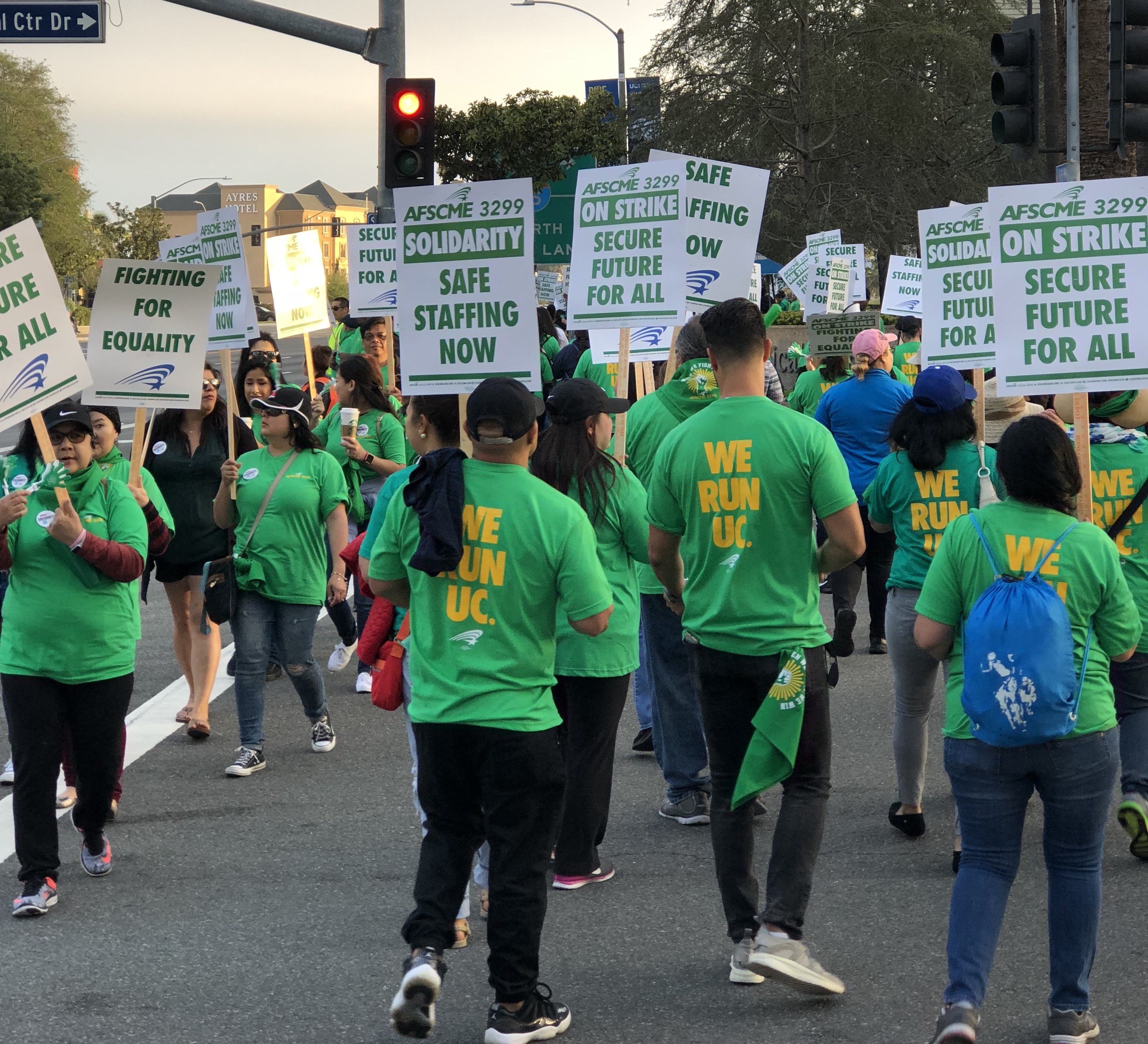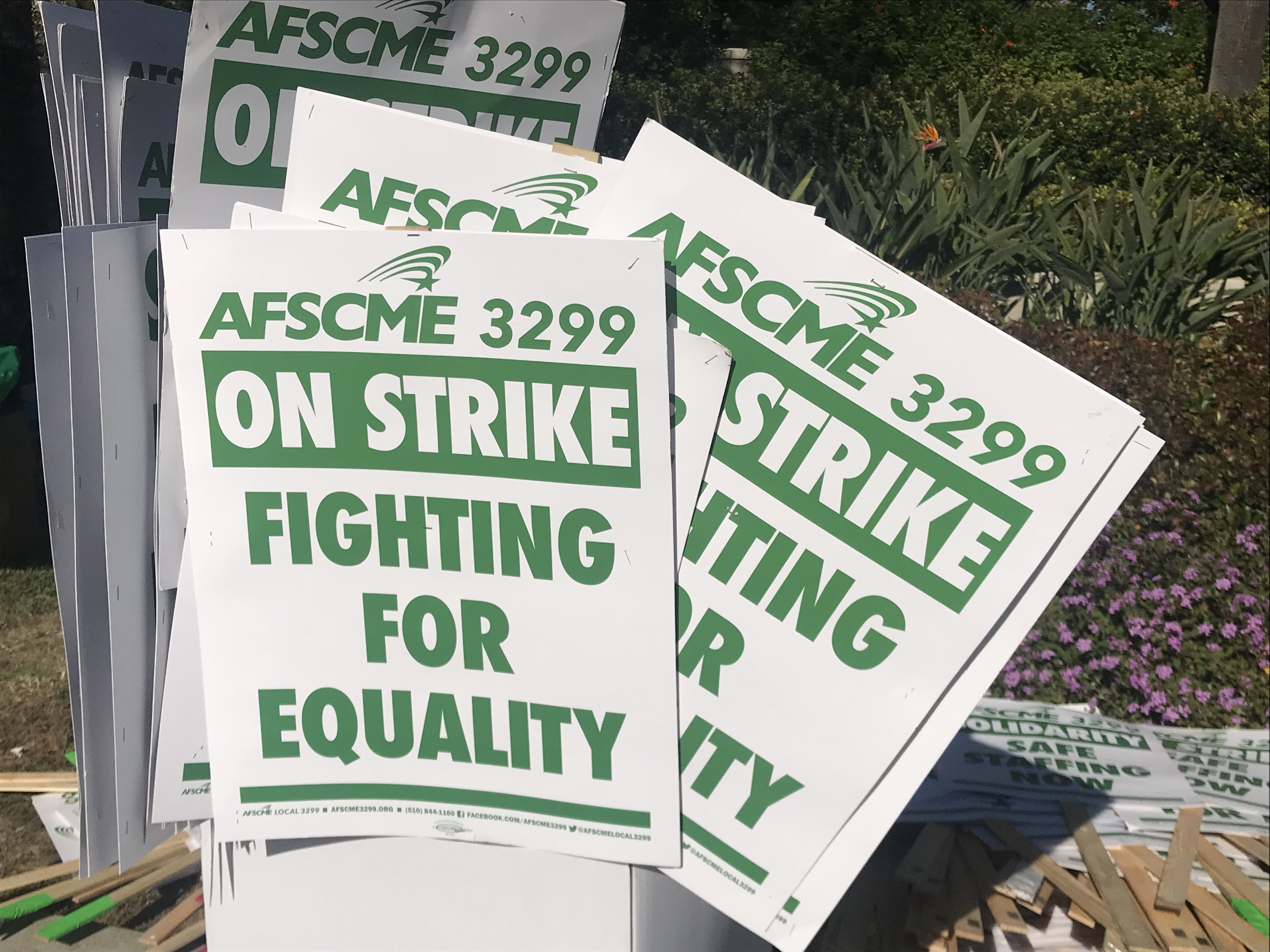
Hundreds of UC Irvine workers walked outside the university’s medical center in Orange on Monday donning green union shirts with picket signs in hand. Represented by the American Federation of State, County and Municipal Employees (AFSCME) Local 3299, they’re back this morning and will keep the line moving until Wednesday night in joining a statewide three-day strike against the UC system. The “green machine” made the move after a year’s worth of stymied contract negotiations.
“There’s a growing inequality among UC employees,” says Monica de Leon, a unit secretary in labor delivery at UC Irvine Medical Center. She’s also AFSCME 3299’s vice president of the patient-care unit. “We have over 5,000 employees that make more than the governor while the majority of our AFSCME workers qualify for some form of financial assistance.”
The union, which represents more than 24,000 workers at the UC’s ten campuses and five medical centers, alleges that the inequities its members endure sharpen along racial and gender lines. To bolster their case, AFSCME 3299 released “Pioneering Inequality: Income, Racial and Gender Inequality at the University of California” ahead of the statewide strike. It found that amid growing inequalities between 2005-2015, racial pay gaps are most prominent among frontline patient care workers, where white men and women have higher starting wages on average than all other demographic groups. In the service sector, men from diverse backgrounds topped women’s starting pay with white guys leading the way.
Black service and patient-care workers also comprise far less of the union workforce than they did in 1996. The report charted a 37 percent decline by 2015. Black women who remain suffer the greatest pay inequities in both sectors, making 10-23 percent less in starting pay compared to their white male counterparts. Outsourcing only exacerbates racial inequalities. “Obviously, we are a diverse campus here in Irvine, but it’s a problem anywhere,” says De Leon. “They keep bringing in the outsourcing problem into our university at the medical centers and the campuses.”
A UC spokeswoman criticized the union report’s timing. “We cannot confirm the accuracy of the report created and written by AFSCME, and it was not part of the independent fact finding that was conducted as part of our negotiations,” stated Claire Doan, the UC office of the president’s director of media relations. “Union leaders planned the release of the report to coincide with the height of negotiations with UC.”

Down at the medical center, striking workers held picket signs reading “safe staffing now.” Back in October 2016, Dr. Howard Federoff, former CEO of UC Irvine Health, began overseeing a heavy layoff of 175 staffers deemed an “operational transformation“at the medical center. He resigned from the position this February without having addressed AFSCME 3299 concerns about staffing. “They’re trying to get more out of us every day instead of hiring the workers we’ve asked them to hire,” says De Leon. Things haven’t fared much better in the transition with Richard Gannotta as interim CEO and Alan Goldin as interim vice chancellor, in splitting the administrative position in two. Meanwhile, the union reports shortages in nursing, food and environmental services workers.
“UC feels that it is highly inappropriate that AFSCME is now using a strike as a negotiating tactic,” Doan added. “This is after union leaders rejected, without conducting a vote among their members, UC’s proposed multi-year wage increases (3 percent annually for four years) and excellent health and retirement benefits.”
With the UC system celebrating its 150th anniversary, president Janet Napolitano made a recent appearance in Orange County alongside UC Irvine chancellor Howard Gillman. Together, they visited Anaheim High School on Apr. 27 for a rally with hundreds of students. Napolitano came as part of Achieve UC, a program encouraging students at low-income school sites to enroll in higher education. De Leon, an Anaheim resident, only learned of Napolitano’s visit through fellow parents, and much too late for the union to have responded to her presence. Around that same time, UC lodged complaints with the Public Employment Relations Board but only won in keeping a small number of “essential employees” they sought to keep from striking in a court decision last week.
By late afternoon, blue-shirted security guards kept watch over striking workers, some of whom already put in 12 hours on the line. AFSCME 3299 counted on support from the offices of Democratic elected officials like assemblyman Tom Daly, assemblywoman Sharon Quirk-Silva, and state senator Josh Newman. The Service Employees International Union, Orange County Employees Association and the United Nurses Association of California turned out in solidarity. Sympathy strikers from California Nurses Association (CNA) and University Professional & Technical Employees (UPTE) CWA are bolstering the numbers along the City Drive today and tomorrow.
It’s been weeks since the UC has come to the bargaining table with AFSCME. If the stymie continues after the three-day strike remains to be seen. “At the end of the day, we want to make sure that we have stable pensions and secure futures.” says De Leon. “The main reason why we’re here for the strike is we need to highlight the problems that have been ongoing for years and the university has failed to do anything about them.”


Gabriel San Román is from Anacrime. He’s a journalist, subversive historian and the tallest Mexican in OC. He also once stood falsely accused of writing articles on Turkish politics in exchange for free food from DönerG’s!

